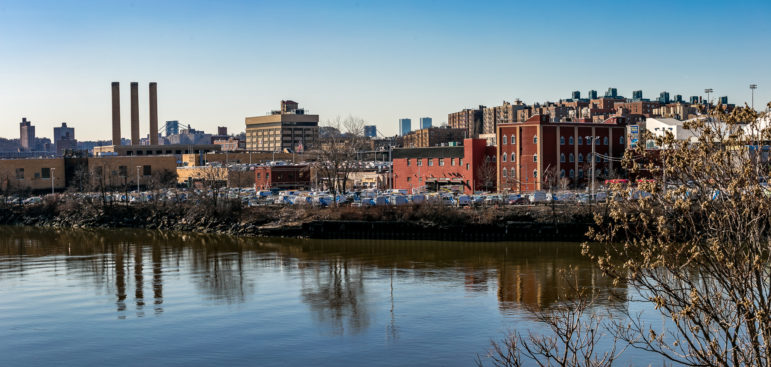
Adi Talwar
Inwood will likely be the fifth neighborhood to be rezoned by the de Blasio administration.
“The [Economic Development Corporation] gave us a bunch of rotten bananas and the community turned it into some delicious banana bread.”
That’s what community activist Chris Nickell says he’s been telling Manhattan Community Board 12 members, with gratitude, and why he plopped some homemade chocolate banana bread in front of the board’s executive committee following its approval of a detailed resolution calling for changes to the city’s proposed Inwood rezoning.
The Economic Development Corporation has proposed rezoning several parts of Inwood to promote greater residential and commercial development, with a portion of new housing required to be income-targeted under the city’s mandatory inclusionary housing policy. The city has also promised a suite of investments and initiatives that it says will spur economic development, protect existing residents from displacement, and encourage waterfront access, among other goals.
The proposal is the fifth of the de Blasio administration’s neighborhood rezonings to undergo the seven-month public review process known as ULURP that leads to a rezoning’s approval. Per ULURP rules, Inwood’s community board has until March 26 to make a (nonbinding) recommendation on the city’s proposal.
On Thursday, the board’s executive committee unanimously approved a resolution that incorporated many of the demands raised by community groups over the past month, with chair Shah Ally commending the detailed recommendations from Uptown United, a coalition of groups including Northern Manhattan Is Not For Sale, Save Inwood Library, Inwood Small Business Coalition and others that put forward its own plan last month. When the committee’s resolution passed, members of the audience applauded and snapped.
You can see a photographed copy of the committee’s draft resolution on the Inwood rezoning here, though what passed Thursday followed a few tweaks, and additional tweaks are still expected. The entire board will vote on the resolution at its next full board meeting on March 20.
A nuanced response
Board member Wayne Benjamin, who as chair of the Land Use Committee spearheaded the writing of the resolution, said that instead of choosing one of the four ways that boards usually respond to land use proposals—with a vote of “yes,” “yes with conditions,” “no,” or “no with conditions,”—the resolution instead offered a “fifth version” with more nuance.
The resolution declares that the board “does not support the Zoning Map amendments as proposed” and proceeds to recommend seven changes.
One of those changes is to “reduce the maximum building heights allowed for new construction in the Commercial U to avoid competing with view corridors of the Cloisters and to relate more sympathetically to existing buildings.” This is a reference to portions of West 207th Street, Broadway, and Dyckman, which EDC had recommended upzoning to a higher density, with height caps of 11 stories or up to 14 stories on corners.
The board also wants reductions in the proposed height limits for buildings on 10th Avenue and Broadway between 215 and 218th Street. And while it regards the areas east of 10th Avenue and Broadway as having the potential for growth, it calls for reductions in the height of the densest construction permitted east of 10th avenue “to relate to the scale of the Dyckman Houses,” which is a 14-story NYCHA complex, and in all those areas to “ensure that there is no visual encroachment to or from, or shadowing of, Inwood Hill or Isham Parks,” among other changes.
Responding to demands to protect small businesses, the resolution asks for limitations in the size of new retail establishments (foreseeably to prevent an influx of chain stores). It also urges the city’s Department of Housing Preservation and Development (HPD) to develop all residential development on city property “to be 100 percent affordable at the income range of Inwood residents.”
On private property, the board wants development governed by the mandatory inclusionary housing option that requires the deepest affordability—20 percent of apartments to be affordable to households making below $34,360 for a family of three. It also urges HPD to provide subsidy to developers on private land “to ensure that a higher percentage of units, i.e. an additional 15 percent, must be permanently affordable.” Of course, much depends on the willingness of developers to take city subsidy and provide additional amounts of affordability in exchange.
The resolution echoes some community members in objecting to the city’s incorporation of the redevelopment plan for the Inwood library into the rezoning land use application, saying the Inwood library redevelopment plan “should be addressed independently.” And it includes a variety of other recommendations relating to preserving indigenous and African-American heritage sites, modernizing infrastructure, immediately initiating a process to contextually rezone other specified areas of the neighborhood, as well as endorsing a list including almost 40 “programs and initiatives” across a range of topics, from investments in community resources, to protecting tenants and small businesses, to facilitating affordable development on public sites, and more.
Positive reviews so far
Nickell and Paul Epstein, both of whom helped spearhead the Uptown United platform, said they were impressed by the board’s resolution, though added they needed to read it more closely.
“This is a lot more than I could have expected,” said Epstein, saying that the board had listened to the feedback provided by community residents at a host of meetings. He said he found the repeated emphasis on protecting park views a little odd—Uptown United’s members, when calling for reduced density, were primarily concerned with halting business and tenant displacement—but that he appreciated that the board also included initiatives to protect small businesses and residents from displacement.
Of course, the resolution isn’t exactly the same as Uptown United’s plan. For instance, the latter called for a lower density zoning designation for the “Commercial U” than proposed by the city. It called for setting aside some land in the areas east of 10th Avenue to preserve wholesale businesses and designating other areas with mixed residential and industrial zoning. And it demanded 100 percent affordable housing in all upzoned areas and that the city invest in purchasing distressed properties throughout the neighborhood and place them in a community land trust.
Asked by City Limits to respond to some of the differences between the two plans, Nickels acknowledged the ambitiousness of their demand for 100 percent affordability on all upzoned land, but also said members would continue to advocate for these elements of Uptown United’s vision. He also said he would have liked to see the board pick a reduced zoning designation for the Commercial U, but that calling for lower heights in that area “is a step in the right direction.”
Peter Psthsas, whose family owns a property on Broadway and seeks to redevelop it, said he thought overall the resolution was a good thing, but added that “We need to be careful what we ask for…The more of a burden we put on developers, the higher the price of construction.” Restricting density, imposing more design requirements or requiring higher amounts of affordability could ultimately depress the amount of housing built in Inwood, he argued.
Borough President Gale Brewer will host a hearing on the Inwood rezoning at I.S. 218, 4600 Broadway, at 6 pm on Tuesday April 10. Watch a live webcast here. Her office is welcoming written testimony or video testimony of about two-minutes, which can be sent to Inwood@manhattanbp.nyc.gov. Councilmember Rodriguez will be hosting a meeting at which he will present his visions for the rezoning on April 29 at 2:30 p.m., Manhattan Bible Church, 3816 9th Avenue between 204th and 205th Street.










3 thoughts on “On Inwood Rezoning, Community Board Committee Adopts Many Residents’ Demands”
I’m impressed by how much hard work and thinking CB12 members who drafted this resolution put into it. Working on a purely volunteer basis, with no pay, they did a better job than the City’s $900,000 EIS/ULURP consultant. I hope if there are any further changes before the full board votes on Tues March 20, they do not weaken what’s already there, and address more issues of concern to community members, such as climate change and risk of flooding.
It is important to note that this planning exercise is being done in the relative absence of meaningful studies that evaluate all the potential environmental, infrastructure, service, and displacement impacts of the upzoning on Inwood. The Uptown United platform pointed this out and Unified Inwood and others including the community board had requested analyses and studies and were rebuffed by EDC which most often said that they didn’t have to do the studies for one reason or another. Inwood is surrounded by water and Parkland and unlike most other neighborhoods there are only a few ways in and out which can easily be choked by traffic. It is unconscionable that the community board, the Borough president, the City Planning Commission and city council are being required to make these enormous decisions for Inwood without this critical information. The planning is being done seat-of-the-pants at this point. And Inwoodites as well as residents who live up and down the subway lines and bus lines that go through it will have to live with the consequences of these hastily made decisions forever. If a mistake is made and too much density is added, and if transit becomes a total nightmare and underground infrastructure fails, the dozens of new buildings can’t be undone.
And flooding from the Harlem River is predicted to get significantly worse by the New York City panel on climate change. Much of East Inwood is already in the flood plain and floods are going to become more frequent and with flooding going further inland as time goes on, and yet there is no discussion of flood buffer and lots of discussion of inappropriate development in the floodplain.
This process needs to slow down and the studies that the Ph.D.s and planners in Unified Inwood that were requested, should be done before this proceeds any further. And planning should err on the side of caution using the precautionary principle.
Real sad we have a small town like feel in northern Manhattan, rest assure this feel be lost. The people who have invested into there housing I’m sure there property value will decrease. This is a multi cultural nieborhood but with strong family values. This will not be a nice for the area but this will surely have people move and I sure out of New York all together.